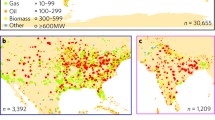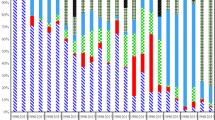Abstract
In recent years, several scholars have recommended that countries reduce their energy-related CO2 emissions by setting carbon intensity targets for their electricity sectors. Other research by Freudenberg suggests that countries could substantially cut their emissions simply by focusing on lowering the intensities of electricity’s most extreme polluters. Using a unique international data source on power plants, we inform this issue by analyzing the distribution of CO2 emissions and intensities within countries’ electricity sectors. We find that the dirtiest 5 % of power plants are responsible for huge shares of their sectors’ total emissions. If these plants continued generating the same amount of electricity but met particular intensity targets, the world’s total electricity-based CO2 emissions could be reduced by as much as 44 %.
Similar content being viewed by others
Introduction
The electricity sector is the largest source of carbon dioxide (CO2) emissions, accounting for a quarter of all anthropogenic greenhouse gases released into the atmosphere. Over the past two decades, the electricity sector’s CO2 emissions have also risen by 60 % worldwide, largely driven by growth in developing countries like China and India (International Energy Agency 2009a). In light of these facts and trends, several researchers have concluded that focusing on reducing the emissions of countries’ electricity sectors is the most effective means to a low carbon future. They suggest further that in the absence of an international cap-and-trade system, the next best strategy for decreasing energy-related emissions is to set targets for electricity sectors’ carbon intensities (pounds of CO2 emissions per megawatt of electricity produced) (International Energy Agency 2009b, c; Center for Clean Air Policy 2008; Egenhofer and Fujiwara 2008; United Nations Framework Convention on Climate Change 2007). According to these researchers, sectoral targets are attractive to countries because they are non-binding, can be adjusted to reflect best available technologies, and do not set limits on countries’ economic growth in the way that emission caps do. In particular, sectoral targets are more manageable than economy-wide approaches.
Critics, however, have raised several objections about this policy strategy (International Energy Agency 2009b; World Resources Institute 2006). They contend that because sectoral targets are voluntary, they tend to be environmentally lax. In many countries, emission intensities have also declined over time, even in the absence of targets, due to improvements in technical efficiency. And countries’ emission levels and rates are only weakly correlated, with some countries experiencing increases in levels despite improvement in their rates. Finally, critics argue that setting targets at the sectoral level may not be enough to drive change at the plant level—some plants’ efforts to lower emissions may be offset by others’ unwillingness to do the same.
Interestingly, while proponents have been quick to respond to the first three objections about the legal status, stringency, and form of sectoral targets, they have been slow to address the last one about their scope. They have suggested, for instance, how countries can improve their monitoring capacity, what baselines might be used to compare future emissions against, and how targets may be adjusted to lower emission levels (World Resources Institute 2006). However, they have yet to explore differences in the level and rate at which power plants emit carbon dioxide. This is despite related research by Freudenburg (2005) on toxic pollution in USA. Using firm-level data from the Toxic Release Inventory, Freudenburg found that a small subset of a sector’s facilities is often responsible for the lion’s share of its toxic emissions (see also Berry 2008). For example, just two companies—DuPont and Freeport-McMoRan—were responsible for nearly a third of all toxic releases from the US chemicals sector. Moreover, disproportionalities in toxic releases were amplified when industries were normalized by size, suggesting that high levels of toxic releases were not due to higher levels of production in some industries versus others. Freudenburg concluded that toxic pollution could be mitigated significantly if only a small fraction of producers were to become more efficient, and that such improvements would not come at the expense of economic growth or industry survival.
Similarly, we investigate whether considerable reductions in carbon emissions can be achieved if regulators simply focus on lowering the intensities of an electricity sector’s most extreme polluters. One possible reason why proponents have not explored this issue is that they presume that if some power plants emit more carbon dioxide than others, it must be because they generate more electricity and/or use more carbon-intensive fuels. Even if true, though, it raises an intriguing empirical question: How much would electricity-based CO2 emissions be reduced if countries set intensity targets only for their most extreme polluting power plants?
Methodology
To answer the latter, we use a unique international data source on power plants’ emissions recently compiled by the Center for Global Development called Carbon Monitoring for Action or CARMA (Wheeler and Ummel 2008). CARMA draws on three data sets: plant-level emissions reports from the USA, European Union, Canada, and India; global plant- and company-level data from Platt’s World Electric Power Plants Database; and country-specific power production data from the US Energy Information Agency. For non-reporting plants, CARMA estimates emissions using a statistical model fitted to data for the reporting plants and detailed data from the other two sources on plant-level engineering specifications. Thus, CARMA provides better cross-national coverage than any other existing source.
In examining the emission reductions that could be achieved by applying different intensity targets to the most extreme polluters, our goal is not to determine which target is optimal. Nor do we seek to assess targets’ political and economic feasibility. Rather, we hope to stimulate discussion about and future research on how more manageable sectoral strategies could be devised by taking into account the uneven distribution of CO2 emissions at the plant level.
Results
Columns 1 and 2 of Table 1 report the emission levels and rates of the 20 countries with the most overall greenhouse gas emissions. Together, these countries are responsible for 82 % of the world’s total electricity-based CO2 emissions. Column 3 shows what share of a country’s electricity-related CO2 emissions can be attributed to the top 5 % of polluting power plants. In China’s electricity sector, the top 5 % account for over a third of total CO2 discharges. In the next two most heavily polluting countries—the USA and India—the top 5 % are responsible for nearly double that amount (or three fourths of emissions). And in a near majority of the remaining countries, the top 5 % account for 90 % or more of all carbon emissions.
While the uneven distribution of carbon emissions partially reflects the fact that the top 5 % also generate a large share of their sector’s total electricity, as column 4 would suggest, it is still the case that, except in Saudi Arabia, these plants emit more CO2 per unit of electricity produced than the average plant, as shown in column 5. In China, for instance, the worst polluters emit carbon dioxide at a rate 1.92 times greater than the average plant. Obviously, the fuel used by these plants may be an important determinant of their higher emission rates. For example, the fact that a relatively small percentage of electricity is generated from fossil fuels in countries like Canada, Brazil, and France would suggest that their top 5 % of polluters are among the few that use such fuels (see column 6). Still, the fact that a small subset of plants has both higher emission levels and rates would suggest that narrowing the scope of sectoral strategies to focus on these polluters might yield substantial reductions in emissions.
Table 2 narrows the scope to only power plants in each of the 20 nations that use fossil fuels. Column 1 reports the emission rate for fossil fuel power plants, column 2 reports the top 5 % share of sector’s electricity generated from fossil fuels, while column 3 reports the emission rate ratio of the top 5 % to the average for fossil fuel power plants. Comparing column 1 in Table 2 with column 1 in Table 1 indicates that with the exception of South Africa and Australia, the emission rate of fossil fuel power plants is higher than the emissions rate for the entire electricity sector. The top 5 % share of the sector’s electricity generated from fossil fuels ranges from 51 % in China to 97 % in Germany, with 7 of the other 20 nations having shares above 90 % (column 2). Seven of the 20 nations have emission rate ratios of the top 5 % to the average for fossil fuel power plants below a value of 1 (column 3), with Saudi Arabia and Mexico having the lowest shared value of .83, followed closely by Canada (.86) and Brazil (.87). For the 13 nations having ratios above a value of 1, the USA has the largest at 1.35, followed by Taiwan (1.32), South Africa (1.25), and Australia (1.17).
Table 3 reports what percent of a country’s total electricity-based CO2 emissions would be erased if their top 5 % of polluting power plants continued to generate the same amount of electricity but lowered their intensities to the average for all power plants in a country’s electricity sector (column 1), to the average for all power plants in the world (column 2), to the average for all fossil fuel power plants in a country’s electricity sector (column 3), to the average for all fossil fuel power plants in the world (column 4), by 30 % or the equivalent of switching from coal to natural gas (column 5), and by 85 % or the equivalent of adopting carbon capture and storage technologies (column 6). In the last row, it reports what impact each of these six strategies would have on the world’s total electricity-based CO2 emissions.
As column 1 shows, if the top 5 % of polluters lowered their intensities to the average for their sector, it would, with the exception of Saudi Arabia, result in a reduction of CO2 emissions in every country, ranging from 8 % in Iran to 79 % in Germany. If the same plants lowered their intensities to the world average for power plants, each country would register a reduction of at least 16 %. Some might object that using such averages is inappropriate because they include plants using non-fossil fuels. A more appropriate comparison, therefore, might be to use averages for fossil fuel plants. Columns 3 and 4 show that if the sectoral and world averages for such plants were used as targets, the results would be less positive. Nearly a third to one half of extreme polluters would experience moderate increases in their emissions because their intensities are already lower than their peers. Presumably, in these cases, an appropriate strategy might be for moderately polluting yet less efficient plants to reduce their intensities to the level of more efficient yet still extreme polluters. However, overall emissions reductions in these cases would likely be minimal without additional reductions by the extreme polluters themselves.
The last two columns report how much CO2 emissions would decline if plants used their own intensities as their baseline. Column 1 shows that if plants reduced their intensities by 30 %, which is roughly the same as converting plants from coal to natural gas, emissions levels would be cut by 6 % (South Africa) to 30 % (Germany). Column 6 estimates the effect of extreme polluters incorporating technologies capable of capturing and storing roughly 85 % of carbon emitted per unit of electricity generated. In countries like Japan, Germany, the UK, and Italy, three fourths of electricity-based emissions would be erased.
Finally, the last row of Table 3 reveals that depending on the target applied to extreme polluters, the world’s electricity-based CO2 emissions could be reduced from a modest 5 % (if intensities were lowered to the average for sectors’ fossil fuel plants) to a substantial 44 % (if plants incorporated carbon capture and storage technologies).
Conclusion
While our analysis offers new insight into the possible uses of sectoral intensity targets, it does not address several issues surrounding them, including whether they reduce cost uncertainties, their interactions with existing regional and sub-national emission trading systems, and possible rebound effects associated with intensity improvements (World Resources Institute 2006). It also does not examine the legal obstacles to implementing a mitigation strategy that singles out a subset of facilities within a sector. If our understanding of extreme polluters and policies aimed at them is to advance, more research will be needed along these lines.
Nonetheless, our study reveals the potential efficiencies that might be realized if sectoral policies took into account the highly uneven distribution of CO2 emissions within electricity sectors. Scholars have not explored these possibilities, even though one of the primary motivations behind sectoral approaches was to concentrate on the largest sources of carbon pollution. By taking this idea and applying it to the level of individual plants, even more effective sectoral strategies might be constructed.
References
Berry L (2008) Inequality in the creation of environmental harm: looking for answers from within. Equity Environ 15:239–265
Center for Clean Air Policy (2008) Sectoral approaches: a pathway to nationally appropriate mitigation actions. CCAP Interim Report, December 2008
Egenhofer C, Fujiwara N (2008) Global sectoral industry approaches to global climate change: the way forward. Centre for European Policy Studies Task Force Report
Freudenburg WR (2005) Privileged access, privileged accounts: toward a socially structured theory of resources and discourses. Soc Forces 84(1):89–114
International Energy Agency (2009a) World energy outlook. IEA, Paris
International Energy Agency (2009b) Sectoral approaches in electricity: building bridges to a safe climate. IEA, Paris
International Energy Agency (2009c) How the energy sector can deliver on a climate agreement in Copenhagen. IEA, Paris
United Nations Framework Convention on Climate Change (2007) “Bali Action Plan.” FCCC/CP/2007/6/Add.1, Conference of the Parties on its Thirteenth Session
Wheeler D, Ummel K (2008) Center for global development. Working Paper 145
World Resources Institute (2006) Target: intensity, an analysis of greenhouse gas intensity targets. Washington, DC
Acknowledgments
We thank Kevin Ummel for technical assistance.
Author information
Authors and Affiliations
Corresponding author
Rights and permissions
About this article
Cite this article
Grant, D., Jorgenson, A. & Longhofer, W. Targeting electricity’s extreme polluters to reduce energy-related CO2 emissions. J Environ Stud Sci 3, 376–380 (2013). https://doi.org/10.1007/s13412-013-0142-z
Published:
Issue Date:
DOI: https://doi.org/10.1007/s13412-013-0142-z




